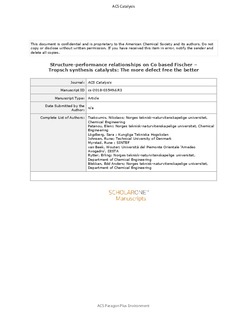Structure-performance relationships on Co based Fischer–Tropsch synthesis catalysts: The more defect free the better
Tsakoumis, Nikolaos; Patanou, Eleni; Lögdberg, Sara; Johnsen, Rune; Myrstad, Rune; Van Beek, Wouter; Rytter, Erling; Blekkan, Edd Anders
Journal article, Peer reviewed
Accepted version

Åpne
Permanent lenke
http://hdl.handle.net/11250/2596002Utgivelsesdato
2018Metadata
Vis full innførselSamlinger
Sammendrag
Understanding and utilizing structure–performance relationships in catalytic nanomaterials is the epitome of catalysis science. Knowledge at the atomic level can potentially allow rational design of more selective and energy-efficient catalytic materials. Fischer–Tropsch synthesis on cobalt is an example of a complicated system that operates in a narrow process regime, and the nature of the reaction product is governed by numerous parameters. On an industrial model catalyst, we have simplified the structure of the active, metallic nanoparticles into a predominantly hexagonal close-packed structure via the use of a Co2C precursor. By varying the final reduction temperature, we could mildly modify catalyst microstructural properties at the nanoparticle (NP) level. Catalytic materials, although with minimal structural differences, showed significantly different performance. Evidently there is a narrow window for complete utilization of the hexagonal close-packed Co crystallites that lies between removal of lattice carbon, that remains from the Co2C precursor, and the initiation of stacking disorder, because of a transition to the face-centered cubic Co structure. Fischer–Tropsch synthesis performance indicators show that Co NPs with minimum number of crystal defects outperform catalysts with lattice defects, because of the existence of either lattice carbon or stacking faults. Therefore, catalyst preparation and activation procedures probably should be designed targeting defect-free Co crystallites.